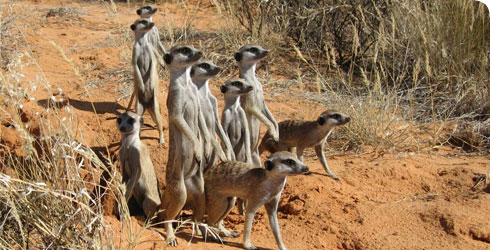Behaviour
Meerkats exhibit many complex social interactions between dominant and subordinate individuals.
Breeding
The dominant female is the main breeding female of meerkat groups, but subordinate females do sometimes breed and their success is dependant on the breeding stage of the dominant female.
In some cases, pregnant subordinate females are driven from the group by aggressive behaviour from the dominant female, while in other cases the subordinate can be so vigorously attacked that the pups are aborted.
If a subordinate does give birth, the pups are at risk of infanticide if the dominant is also about to give birth, but in some cases they do survive.
The gestation period is around 70 days (Hodge et al, 2008) and until the pups are about 3 weeks old they remain underground. They are usually able to forage with the group about 2–3 weeks after they first emerge from the burrow.
Co-operation
When there are young pups in a meerkat group, non-breeding females will also start lactating - known as allolactation - despite not having any pups themselves. These females will often ‘babysit’ the pups whilst the rest of the group is foraging away from the burrow through the day.
Young males will also spend time babysitting the pups - this behaviour is dependent on their foraging success the day before.
When the pups start to forage they are initially brought small, dead prey items by ‘helper’ individuals, which can be either male or female. As they get larger the food they are brought also gets larger and is presented alive rather than dead.
Territory
These animals occupy territories 1–3 kilometres square, depending on group size. When 2 or more groups of meerkats come into visual range of each other, they usually have a non-contact interaction - many individuals of both sexes come together with their tails in the air and ‘war dance’. They approach the other group running and jumping or bouncing up and down. At this point the weaker or smaller group usually backs down and runs away. Occasionally the 2 groups meet and fight until the weaker group leaves.
Other behaviours observed around these inter-group interactions include:
- vigorously scent marking accessible areas with an anal gland under the tail
- dominant individuals asserting their dominance more frequently on to subordinate individuals
- the group creating or using an existing communal latrine
- increasing general dominance and marking behaviours
Guarding
Whilst foraging, meerkats are at risk of predation from the air and on the ground. To increase their chances of survival, 1 or more individuals from the group will climb a tall structure, often a mound, bush or tree, to watch for predators while others continue foraging.
Their eyesight is extremely good which gives the sentry an advantage. Whilst on guard the sentry will produce calls relevant to the threat perceived about a particular predator:
- if something is of interest, but not an actual threat, the sentry will produce a call that alerts others in the group to be vigilant, and the response will be that they also produce the call and look up
- if it is more threatening, the call will increase in intensity and the rest of the group will run to the entrances of bolt holes and watch the predator
- if it is perceived to be a real threat the whole group, including the sentry, will run down a bolt hole and stay there until the threat is gone
- if a snake is encountered, the group will come together in a tight group and ‘mob’ it with their tails in the air whilst making a growling vocalisation
Disease
Meerkats are known to be carriers of bovine tuberculosis Mycobacterium bovis.
